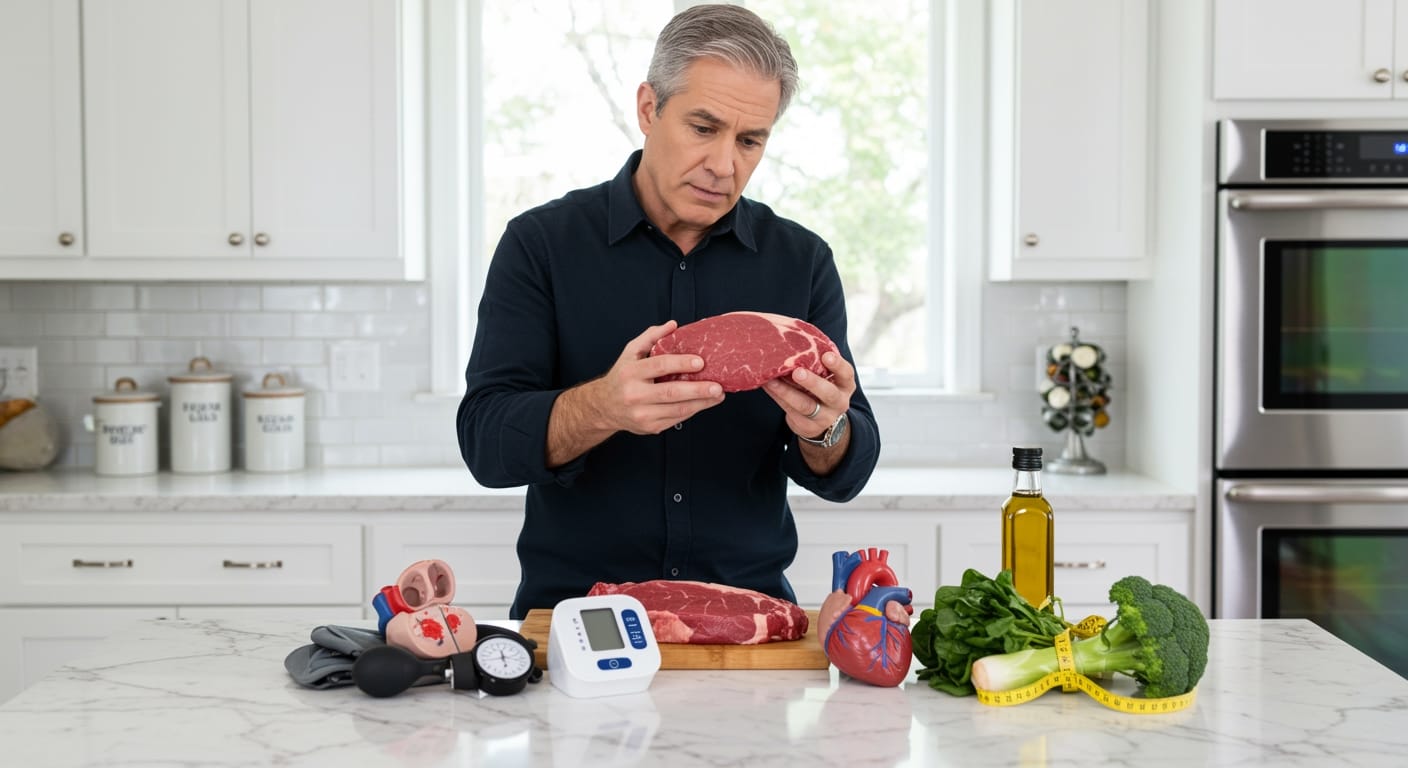✪ Key Takeaway: You don’t need to avoid red meat completely with high blood pressure, but choose lean cuts and limit processed varieties.
Introduction
Your doctor just told you that your blood pressure is too high, and now you’re staring at that juicy steak wondering if you’ll ever enjoy it again.
You’re asking this question because everywhere you look, health experts seem to have different opinions about red meat and high blood pressure, leaving you confused about what’s actually safe to eat.
Hi, I’m Abdur, your nutrition coach, and today I’m going to explain exactly what the science says about red meat and high blood pressure so you can make informed decisions about your diet.
What Does Research Actually Say About Red Meat and Blood Pressure?
The relationship between red meat and blood pressure is more nuanced than most people realize.
Large-scale studies show that processed red meat like bacon, sausages, and deli meats have a stronger association with high blood pressure than unprocessed red meat like fresh beef or lamb.
A comprehensive review published in recent research found that people who ate the most processed meat had a 17% higher risk of developing hypertension compared to those who ate the least.
However, the same studies showed that lean unprocessed red meat in moderate amounts did not significantly increase blood pressure risk when part of an overall healthy diet.
The key difference lies in the sodium content and preservatives used in processed meats, which directly affect your cardiovascular system.
Fresh red meat contains natural potassium and protein that can actually support healthy blood pressure when consumed appropriately.
✪ Fact: Processed meats contain up to 400% more sodium than fresh red meat cuts.
How Does Red Meat Affect Your Blood Vessels?
Understanding how red meat impacts your cardiovascular system helps you make better choices.
When you eat processed red meat, the high sodium content causes your body to retain more water, increasing blood volume and putting extra pressure on your artery walls.
The preservatives in processed meats, particularly nitrates and nitrites, can interfere with your body’s natural nitric oxide production, which is essential for keeping blood vessels relaxed and flexible.
At the cellular level, excessive sodium from processed meats disrupts the delicate balance of sodium and potassium in your cells, affecting how your heart muscle contracts and how your kidneys regulate fluid balance.
Fresh red meat, on the other hand, provides high-quality protein that supports the production of angiotensin-converting enzyme inhibitors naturally, which can help maintain healthy blood pressure.
The iron in red meat also plays a crucial role in oxygen transport, but excessive iron from overconsumption can contribute to oxidative stress in blood vessels.
✪ Pro Tip: Choose grass-fed beef when possible as it contains more omega-3 fatty acids that support heart health.
Which Types of Red Meat Are Better for Blood Pressure?
Not all red meat is created equal when it comes to blood pressure management.
Lean cuts like eye of round, top round, and sirloin tip contain less saturated fat and are better choices for people with high blood pressure.
These cuts provide essential nutrients like protein, iron, and B vitamins without the excessive fat that can contribute to inflammation and arterial stiffness.
Ground beef with 90% lean content or higher is another good option, especially when you drain the fat after cooking.
Avoid heavily marbled cuts like ribeye or T-bone steaks, as the high saturated fat content can contribute to arterial inflammation and reduced blood vessel flexibility.
Organ meats like liver are nutrient-dense but should be limited due to their high cholesterol content, which can indirectly affect blood pressure through cardiovascular health.
The cooking method matters too – grilling, broiling, or roasting without added fats is better than frying or cooking with excessive oils.
✪ Note: Trim visible fat before cooking to reduce saturated fat intake by up to 30%.
How Much Red Meat Is Safe with High Blood Pressure?
Portion control is crucial when including red meat in a blood pressure-friendly diet.
Health experts recommend limiting red meat intake to no more than 3-4 servings per week, with each serving being about 3-4 ounces (roughly the size of your palm).
This amount provides the nutritional benefits of red meat without overwhelming your cardiovascular system with excessive saturated fat or sodium.
For people with existing high blood pressure, starting with 2-3 servings per week and monitoring your blood pressure response is a smart approach.
Balance your red meat consumption with plenty of vegetables, whole grains, and other heart-healthy foods that provide potassium and fiber to counteract any negative effects.
Remember that your total dietary pattern matters more than any single food, so focus on creating meals where red meat is just one component alongside nutrient-dense vegetables and whole grains.
✪ Pro Tip: Use a food scale initially to learn what proper portion sizes look like on your plate.
What Should You Eat Instead of Processed Red Meat?
Making smart substitutions can help you maintain flavor while supporting better blood pressure control.
Replace processed meats like bacon and sausage with lean poultry, fish, or plant-based proteins like beans and lentils that provide protein without excessive sodium.
When you crave the smoky flavor of bacon, try turkey bacon or even better, use smoked paprika and herbs to season your food naturally.
Fatty fish like salmon, mackerel, and sardines provide omega-3 fatty acids that actively support healthy blood pressure through their anti-inflammatory properties.
Plant-based proteins like chickpeas, black beans, and quinoa offer fiber and potassium that help regulate blood pressure while providing satisfying protein content.
If you’re making sandwiches, try sliced turkey breast, grilled chicken, or even mashed avocado with vegetables instead of processed deli meats.
These alternatives provide similar satisfaction and nutrition without the blood pressure-raising effects of high-sodium processed meats.
✪ Fact: Eating fish twice a week can reduce blood pressure by an average of 2-3 mmHg.
The Bottom Line
You don’t need to completely eliminate red meat from your diet if you have high blood pressure, but you do need to be strategic about your choices.
“The key to managing blood pressure isn’t about avoiding entire food groups, but about making informed choices that support your long-term health goals.”
I’d love to hear about your experience with managing red meat in your diet – what challenges have you faced, and what strategies have worked best for you? Share your thoughts in the comments below so we can learn from each other’s experiences.
References
At NutritionCrown, we use quality and credible sources to ensure our content is accurate and trustworthy. Below are the sources referenced in creating this article:





